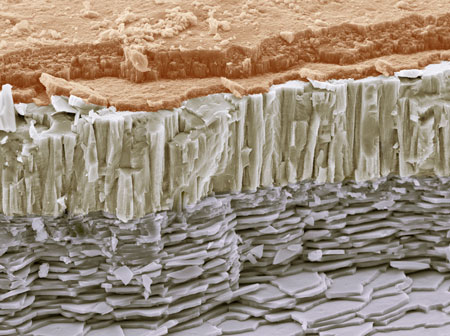| Jan 13, 2012 |
New family of composite structures
|
|
(Nanowerk News) Material scientists at ETH-Zürich are working on composite materials that mimic the structure of seashells. Such complex structures are produced using tiny magnetic particles which guide the composites' stiffer elements into place. This technique enables new technologies from durable coatings to stronger and lighter materials.
|
|
Composite materials are widespread in our society. They are used in a wide range of structures from airplane wings and fiberglass boats to wind turbine blades and dental restorations. Because composites combine different classes of materials such as plastics, metals, and ceramics, it is possible to design them to be simultaneously stiff and strong, light and flexible. Such combination of properties cannot be achieved using one class of material alone; plastics aren't stiff, metals aren't light, and ceramics aren't flexible.
|
 |
| Cross-section of the abalone seashell (Haliotis sp.), illustrating the deliberate spatial and orientational control of CaCO3 reinforcing elements in a unique 3D architecture.
|
|
The design and fabrication of composites that achieve these property combinations requires the proper orientation and placement of strong and stiff ceramic or polymeric fibers within a softer and lighter polymeric material such as an epoxy glue. Without proper orientation, the stiffer elements are ineffective in their role of strengthening the softer material.
|
|
High stiffness and strength
|
|
The ability to control this orientation has long eluded composite manufacturers. Current composite materials contain stiff fibers often arranged as a piece of fabric, which is later infiltrated with a soft, light polymeric resin. This provides high stiffness and strength in the plane of the fabric that can be easily observed by pulling on the ends of a single fabric layer. Current manufacturing techniques stack numerous thin layers to create larger structures.
|
|
However, this typically leads to composites with weak impact resistance and high susceptibility to delamination between stacked layers. Interestingly, composite materials produced by living organisms exhibit elegant solutions to these problems by building biological composites using reinforcing elements with unique 3D architectures, as exemplified by the seashell structure. Similar 3D reinforcing strategies are also found in teeth, bone and plant stems.
|
|
Precise control of reinforcing elements
|
|
In the January 13th issue of the journal Science ("Composites Reinforced in Three Dimensions by Using Low Magnetic Fields"), researchers at ETH-Zurich have disclosed a newly developed technique that allows for the precise control of these stiffer reinforcing elements within a synthetic composite. Their technique employs magnetic forces, relying on a similar phenomena to a bar magnet orienting iron fillings. The key challenge was the fact that the materials of interest for composites are nonmagnetic and, thus, do not themselves react to magnet forces.
|
|
The ETH team discovered that they could enable a magnetic response in these materials by attaching a surprisingly small amount of magnetic nanoparticles (1/1000th the diameter of a human hair) on the surface of the stiff elements. This method only works for stiff elements of a defined size in the micrometer range, which happens to overlap with the sizes of key interest in the composite industry. Using stiffer elements on this scale provides orientation control using magnetic fields that are only 20 times that of the Earth. For comparison, credit card stripes emit magnetic fields approaching 2,000 times that of the Earth's field.
|
|
Putting technique into industrial use
|
|
The research team demonstrated that this technique can be used to produce an entire family of new composite structures not possible before (Figure 2). These new structures exhibit programmable material properties in any desired direction, a characteristic that hasn't been demonstrated with previous techniques. Because the new method relies on such low magnetic fields and small coatings, the applicability in existing manufacturing processes is clear.
|
|
The ETH team is currently working with commercial companies to put this technique into industrial use. The industrialization of this approach offers a pathway to lighter, cheaper, and stronger composite materials for the automotive and aerospace industries and for the development of materials to promote renewable energy harvesting such as with lighter, stronger wind turbine blades.
|
|
The ETH team plans to continue this work by adapting these techniques to a variety of new systems and new materials.
|

